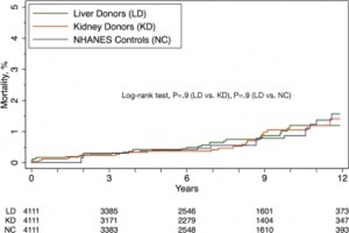Provided by The AGA Journals Blog
Posted on February 27, 2012
by Kristine Novak, PhD, Science Editor
Donating part of your liver is just as safe as donating a kidney—donors of these organs have survival rates similar to the rest of the population, according to an article in the February issue of Gastroenterology.
With organ shortages, live-donor liver transplantation (LDLT) is a lifesaving alternative to transplantation from deceased donors for patients with end-stage liver disease. Since the introduction of LDLT 20 years ago, thousands of children requiring liver transplants have benefited from left lateral segment grafts from live donors. Adults now also receive liver transplants from live donors. However, the numbers of livers transplanted from live donors has fallen short of the initial expectations over the past 8 years, due to safety concerns.
To determine the safety and side effects of LDLT, Abimereki Muzaale et al. followed 4111 live liver donors in the US from April 1994 to March 2011. They determined rates of deaths from the Social Security Death Master File and compared survival data with those from live kidney donors and healthy participants of the National Health and Nutrition Examination Survey (NHANES) III.
The authors found that the 90-day mortality of living liver donors (1.7 per 1000 donors or 0.17%) did not differ significantly from that of living kidney donors (0.05%). The long-term cumulative mortality risk was comparable to that of live kidney donors and NHANES participants (1.2%, 1.2%, and 1.4%, respectively) at 11 years.
Kaplan–Meier curves of cumulative mortalities for live donors of livers, matched live donors of kidneys, and matched controls (participants in NHANES III).
There were 4 cases of nonfatal acute liver failure in living liver donors; 3 of these patients required deceased-donor liver transplantation.
In an editorial that accompanies the article, James Trotter and James Everhart state that these results are likely the best estimation of donor mortality, and that this information will be useful for clinicians in counseling potential LDLT donors and recipients. They add that the format of cross-referencing 2 databases provides an important study design for future estimates of donor mortality.
Previous studies reported that physical well-being of donors decreases after surgery, but returns to pre-donation levels within 1 year. Out-of-pocket expenses and lost wages have been estimated to average about $5,000 for donors, although this amount varies greatly.
Nonetheless, Trotter and Everhart say it is important to consider the intangible benefits of an altruistic act. Other benefits include having a loved one remain alive and returned to function, as well as a public health benefit—living donation allows another patient to receive a deceased donor liver, thereby decreasing the demand for deceased donor transplantation.
Trotter and Everhart conclude that the findings of Muzaale et al. set the standard for estimating donor mortality. “Because the liver community has been unable to establish a national database for donor outcomes, and there are no real prospects for such, the rigorous methodology utilized in this study will allow the best means of prospectively reporting living liver donor mortality risk in the future.” However, further studies are needed to determine long-term outcomes of LDLTs.
Read the article online.
Muzaale AD, Dagher NN, Montgomery RA, et al. Estimates of early death, acute liver failure, and long-term mortality among live liver donors. Gastroenterology 2012;273–280.
Read the accompanying editorial.
Trotter JF and Everhart JT. Outcomes among living liver donors. Gastroenterology 2012;207–210.

No comments:
Post a Comment